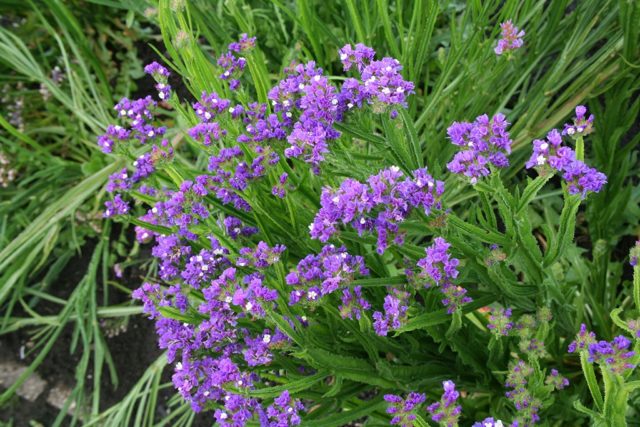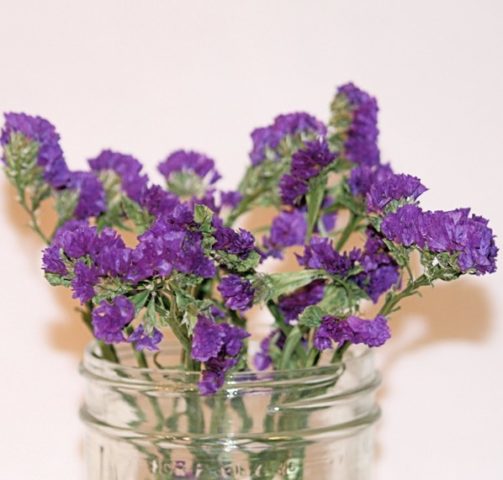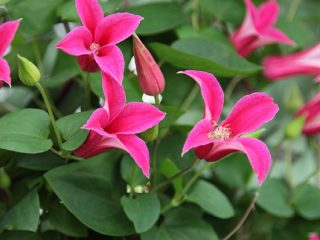Content
Growing statice from seeds at home is the most popular way to propagate this crop. Other methods often cause many difficulties due to the sensitive root system of the plant. Seeds for growing seedlings can be collected independently at a certain time, or purchased in specialized stores.
Features of growing statice from seeds

Statica (kermek) is an amazingly beautiful plant with small flowers.
Statica or kermek (another name for limonium) is a plant from the Pigaceae family. Representatives are found on almost all continents, growing mainly on saline soils. They are perennials, some varieties are classified as herbs, others as shrubs. The leaf blade is very large, but located close to the soil. The inflorescences are collected in panicles, the flowers are small, yellow, burgundy or pink.
Recently, interest in this culture has increased significantly. This is due to the decorative properties of the plant and the use of statice in landscape design. Therefore, many new hybrid varieties are appearing.
Static has excellent endurance. Thanks to the long, rod-shaped root system, the plant develops well in any difficult conditions. Therefore, growing kermek (limonium) from seeds will not require much trouble. You need a little skill to choose the right sowing period, prepare the soil and planting material. In addition, it is important to choose the right place of growth for statice so that it can develop comfortably. In its natural habitat, the plant inhabits the shores of seas and rivers, so it is not afraid of well-ventilated areas. The soil should have a crumbly structure. In such soil, excess moisture does not stagnate and there is good air circulation.
Planting statice on seedlings
Seedlings are often purchased in stores, and experienced gardeners grow Kermek from seeds themselves. The process will require compliance with certain rules: preparation of planting material, soil, containers for seedlings, as well as compliance with other important nuances. Such preparations for growing seedlings will help the proper growth and development of the plant.
When to plant statice seedlings
Sowing statice seedlings should be done only after proper preparation. The best period is the beginning of March.In this case, by the time the seedlings are planted in open ground, the seedlings will be quite strong and prepared. The appearance of the first shoots can be expected after 5 days.

In nature, statice likes to grow on loose, sandy soils.
Preparing containers and soil
To sow statice seeds for seedlings, you will need a universal soil mixture, which can be purchased in stores. But many gardeners prefer to prepare the soil with their own hands, believing that this crop requires special soil. To do this, add sand to it, carefully sift the resulting mixture, and then calcinate it in the oven for an hour at a temperature of at least 100 °C. After this, the soil needs to be moistened.
Static seedlings should be planted using seeds in separate containers that need to be treated with a manganese solution. The most suitable tableware is disposable cups, including peat cups.
Seed preparation
Proper preparation of planting material in order to obtain healthy seedlings is a very interesting process. Statice seeds are covered with a kind of film, this makes germination long. It is not recommended to clean it. Therefore, many people use the following trick. Using a rough file or sandpaper, you should slightly process the nose. This procedure is called stratification. It greatly facilitates the germination process. After this, the prepared seeds need to be immersed in Epin’s solution for a couple of hours or in damp sawdust for several days.Then the planting material can be considered ready for sowing.
How to sow statice for planting
First of all, the soil prepared in advance must be distributed into containers. Then add one grain to each glass without deepening them. A thin layer of soil is applied to the seeds on top. After the procedure is completed, the containers are covered with plastic wrap. They should be kept in a warm room. Under these conditions, seedlings will appear fairly quickly.
How to grow statice seedlings from seeds
After planting limonium seedlings and the appearance of the first shoots, the plants will require careful care with the obligatory implementation of certain rules. They are no different from caring for other types of seedlings. Plants will need watering, ventilation, hardening, and loosening of the soil.
Microclimate

The first sprouts of statice require watering, a certain room temperature and moderate humidity.
To grow limonium flowers from seeds, you need a microclimate suitable for seedlings. It is advisable to keep the seedlings in a warm room at a temperature of 16 to 22 °C. Air humidity should be 50-60%. With this regime, the seedlings will be strong and healthy at the time of planting, with several full leaves.
Watering and fertilizing schedule
The soil should not be allowed to dry out. Seedlings need to be irrigated daily with a spray bottle. As for fertilizing, frequent application is not required. If the seedlings are weakened, then experts recommend liquid solutions, Fertik complex fertilizer. As a rule, at the first stage of development, seedlings have enough nutrients from the soil.
Picking
Growing many types of statice from seeds, including Suvorov's limonium, requires diving.However, for many gardeners this issue is controversial. But if the seedlings sprouted too often, then the root system is tightly intertwined with each other. In this case, transplanting into the ground will be significantly difficult. They need to be transplanted because the plants lack nutrition, sunlight and space in cramped conditions. Picking is done when the seedlings have 3 leaves.
The diving algorithm is as follows:
- a few hours before the procedure you need to water the containers with seedlings;
- fill new containers with soil;
- remove the seedlings and place them in new containers;
- water, leave on the sunny side of the room.
During this period, the seedlings will need a sufficient amount of light, otherwise they will be very weak.
Hardening
From mid-April you can start hardening off the seedlings. To do this, the container with seedlings must be taken outside every day, increasing the time spent in the air. By the time the seedlings can be transplanted into the ground, they will be quite ready for this.
Transplantation into the ground

Many people appreciate statice for bouquets in combination with other dried flowers.
Transplanting into open ground should not be delayed, since statice is characterized by the rapid development of the root system. It is recommended to plant after establishing constant above-zero air temperatures. In the weather conditions of central Russia, the end of May is suitable for this. For statice you need a sunny place with loose, drainable soil. The interval between seedlings should be 30 cm.
When and how to collect statice seeds
Statice seeds are very small, oblong in shape. They are harvested in July. It is during this period that the fruits containing the seeds begin to form. They need to be placed in a tightly closed container and stored until spring.
Conclusion
Growing statice from seeds at home is not a particularly difficult task, but it does require certain knowledge, experience and time. All efforts to grow seedlings are more than compensated for after planting the plant in open ground, since limonium is unpretentious. All numerous varieties are beautiful and can decorate any area.









“Using a rough file or sandpaper, you should lightly sand the nose. This procedure is called stratification. » This process is called scarification. And stratification is the treatment of seeds with a temperature difference, for example, holding them for a certain time at low temperatures.